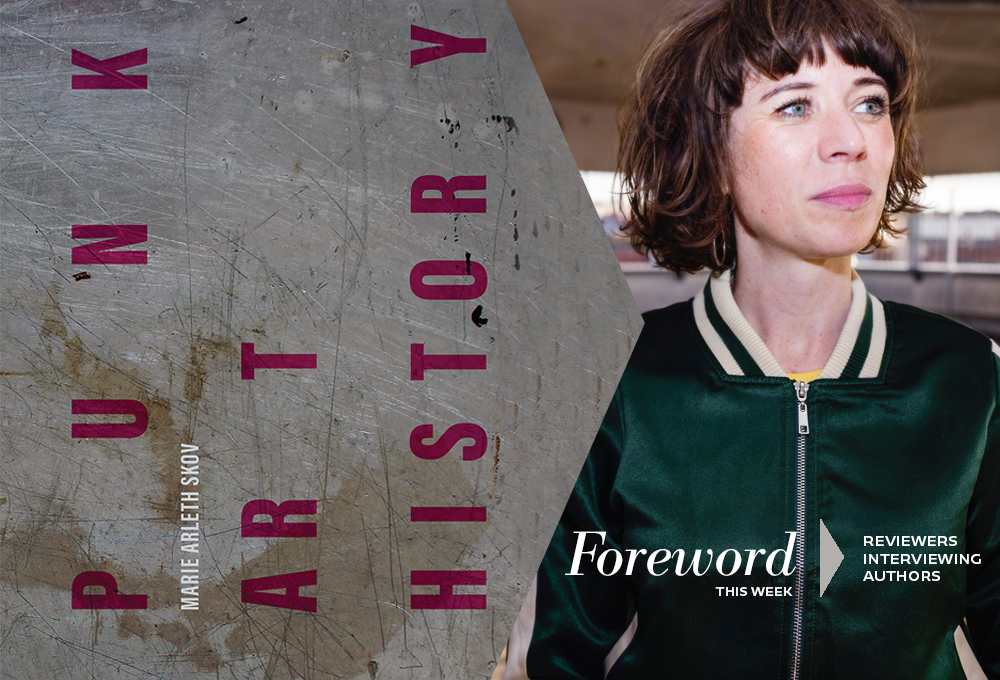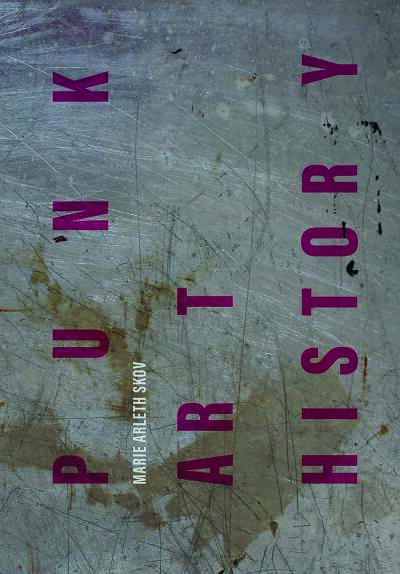Reviewer Meg Nola Interviews Marie Arleth Skov, Author of Punk Art History

What are the ripe conditions for a painter or poet, novelist or songwriter to create a compelling work of art, one that goes beyond aesthetic appeal and proceeds to have a lasting impact on society? The last century offers some convenient answers.
In Russia, during the Stalin years, scores of politically-charged poems and novels earned international acclaim because, well, they captured the despair of a nation beset with terror.
In America, the civil rights movement prompted Joan Baez, Bob Dylan, James Brown, and many others to write songs that moved mountains.

And in Europe towards the end of the twentieth century, punk rockers and artists internalized the flaws of capitalism, class, politics, and urban decay to create a breathtaking array of rebellious art.
This week, Marie Arleth Skov is here to regale us with a few stories about those punksters of the recent past. Her Punk Art History received a starred review from Meg Nola in Foreword and a puckish conversation between reviewer and author fit the FTW bill.
What first sparked your own interest in punk culture?
Even when I was a small child in the early 1980s, in Copenhagen, I was fascinated by the look of punks—these were bigger kids, at school, wearing chains and colorful hair and torn clothing and self-made buttons. To me, they seemed like they had a whole secret world going on, which I imagined to be full of adventures and dangerous things. Then, when I became a teenager in the 1990s, I fell in love with the music too, initially via grunge. I liked Sonic Youth and Black Flag, and that led me to the artwork of Raymond Pettibon. Poetry was another entry point, especially Michael Strunge, a Danish punk poet, who I also included in the book. When I was nineteen, I moved to Berlin where I studied Art History at Freie Universität—and it became clear to me just how much punk has to do with art.
In Punk Art History, you cite Hollow Skai’s observation about how the UK punk movement was primarily youth oriented, with a strong “working-class ethos.” How did this differ from the punk movements in Amsterdam and Berlin, or even in the United States?
Punk manifests differently in each cultural sphere. There are consistent elements too, of course, but like any cultural movement, the societal, historical, political circumstances influence how punk is expressed. In the UK, the class system and the economic recession in the late 1970s made the punk movement more political than it had been in the US. The difference between New York 1975 and London 1976, as two of the best-known fixpoints, was the radical urgency of a youth with a “NO FUTURE” outlook in England. Amsterdam was facing some of the same trouble, especially with regard to housing and squatting, but with a different kind of activist tradition, so punks in Amsterdam were leaning on the Provo movement of the 1960s, for example.
In West Berlin, meanwhile, you had yet another situation: It was only half a city, surrounded by the Wall, by the GDR, with many houses still war-damaged. Famously, Berlin had no curfew, and you could avoid military conscription by moving to West Berlin in those years, which attracted conscientious objectors. West Berlin had a very large and active queer scene, then as now, which mixed with underground artists, Turkish migrant workers, students, and war widows. You had the constant threat of being the first place to fall, should the Cold War turn hot, fueling this “dance on the volcano” atmosphere.
Although punks found some common ground with the counterculture of the late 1960s, they seemed otherwise deliberately contrarian to hippies. From their choice of preferred drugs to their general outlook on life, punks rejected promises of “free love” and positive social change, along with trippy music and flower power fashions. What are some examples of “anti-hippie” punk expression?
Punks rejected what the hippies had, in their eyes, become: complacent, self-righteous, satiated. “Free love” is a good example: Just like punks rejected the heteronormative, conservative family concept, they also did not buy the hippie delusion of having created an alternative, as the sexual revolution had turned out to reproduce unequal power structures.
Instead, punks dismantled the nostalgic myths around romance, while also pinpointing how those myths were often wrapped into commercial stipulations. Punk was in many ways an expression of “back to reality”—a cathartic sense of quitting the pretense and a much darker assessment of the state of society. Nonetheless, as you also observe, punk culture connected with elements of the 1960s too, from self-published zines, DIY, squatting, and activism to personal liberation and subversion through youth culture.
The book elaborates on the darkly hilarious 1983 “Thatchergate” incident, which involved a publicized, mocked-up conversation between then British Prime Minister Margaret Thatcher and US President Ronald Reagan regarding the Falklands War. The “cut-and-paste” dialogue was created by the “anarcho-punk” band Crass, with the intention of keeping Thatcher from being reelected. If the original punks were around today, do you think they’d be manipulating social media or even Artificial Intelligence in similar ways?
That is a great question. I think it is important to conceive just how severe the sense of media pressure was for punks, many of whom were very young, in those years in the UK. The Murdoch press especially was relentless, hateful. Many punk actions were truly created as counter-propaganda, as a form of resistance. The media landscape today, including social media, is of course completely different and difficult to compare, but I do believe that one of the key legacies of the original punk movement is that resistance, the development of counter-strategies to an oppressive situation, strategies that are, as you note, at the same time critical, inventive, and darkly humorous.
By the late 1970s and early 80s, punks were showing up on various episodes of American and British TV sitcoms, generally as sneering, mohawked characters with chains and piercings. Like the Beat Generation became the stereotypical “beatniks” of the 1950s, punks also became a spoofed entity for commercial consumption. Do you think that real punks were angered by this?
Yes. Everything was fast in punk, including the time span from punk’s emergence until it was first declared terminated and the first cooptation began. Already by 1978, Crass had released the track “Punk is Dead” with the lines: “I see the velvet zippies in their bondage gear / The social elite with safety-pins in their ear / I watch and understand that it don’t mean a thing / The scorpions might attack, but the systems stole the sting.”
Punk mid-1970s was like an explosion, sending heatwaves in all directions. The original punk movement splintered into different post- and sub-fractions that still embodied a punk spirit, but in divergent ways: post-punk, anarcho-punk, industrial, no wave, new wave, dark wave, queercore, etc. Some of these fractions were also about avoiding those clichés you describe and be able to move on, while still maintaining some of the initial, true radicality of the movement.
Punk Art History, of course, includes John Lydon, aka Johnny Rotten of the Sex Pistols. In 1977, the Sex Pistols released their famed anti-British monarchy punk anthem, “God Save the Queen”. But when Queen Elizabeth died in 2022, Lydon posted a tribute to her and insisted that the song not be played in a “disrespectful” manner. Does it seem that he’s mellowed with age, or was he perhaps relating that times have changed and so has England?
I can’t speak for Lydon here. My take would be that even back in 1977, the song was less about the Queen personally and more about the system she represents, the pompous monarchy, the ruling class. The song was meant to drive a needle into the inflated arrogance balloon of the establishment. But maybe he has indeed also mellowed with age. I thought his song “Hawaii” which he wrote to his wife, who suffered from Alzheimer’s and died last April, was very moving.
Are you working on any new projects—punk or non-punk related?
I am! On the horizon is our Berlin Symposium on the role of language in punk, which I am organizing together with Aneta Panek and Philipp Meinert, my comrades from the German branch of the Punk Scholars Network. That’s on 22 September 2023.
And then, I am indeed working on a punk art exhibition. It won’t be exactly like the book but still connected … I can’t reveal too much at this stage, so you’re just gonna have to stay tuned for that one!
Meg Nola
